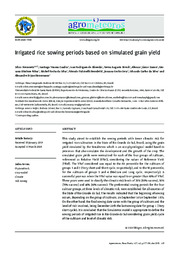Irrigated rice sowing periods based on simulated grain yield.
Irrigated rice sowing periods based on simulated grain yield.
Author(s): STEINMETZ, S.; CUADRA, S. V.; ALMEIDA, I. R. de; STRECK, N. A.; ZANON, A. J.; RIBAS, G. G.; SILVA, M. R. da; BENEDETTI, R. P.; CERA, J. C.; SILVA, S. C. da; HEINEMANN, A. B.
Summary: This study aimed to establish the sowing periods with lower climatic risk for irrigated rice cultivation in the State of Rio Grande do Sul, Brazil, using the grain yield simulated by the SimulArroz which is an eco-physiological model based in processes that also simulates the development and the growth of the crop. The simulated grain yields were normalized for each of the four groups of cultivars, referenced as Relative Yield (YRel), considering the values of Reference Yield (YRef). The YRef considered was equal to the 80 percentile for the cultivars of groups 1 and 2 (Very short and Short cycle, respectively), and to the 90 percentile, for the cultivars of groups 3 and 4 (Medium and Long cycle, respectively). A successful year was when the YRel value was equal to or greater than 60% of YRef. These years were used to classify the climatic risk levels of 20% (80% success), 30% (70% success) and 40% (60% success). The preferential sowing periods for the four cultivar groups, at three levels of climatic risk, were established for all counties of the State of Rio Grande do Sul. The results indicated that the beginning of sowing occurs, depending on the group of cultivars, on September 1st or September 11th. On the other hand, the final sowing date varies with the group of cultivars and the level of risk involved, being December 20th the last sowing date for group 1 (Very short cycle). It is concluded that the SimulArroz model is appropriate to define the sowing periods of irrigated rice in Rio Grande do Sul considering grain yield, cycle of the cultivars and level of climatic risk.
Publication year: 2019
Types of publication: Journal article
Keywords: Arroz, Arroz Irrigado, Clima, Oryza Sativa, Risco Climático
Observation
Some of Embrapa's publications are published as ePub files. To read them, use or download one of the following free software options to your computer or mobile device. Android: Google Play Books; IOS: iBooks; Windows and Linux: Calibre.
Access other publications
Access the Agricultural Research Database (BDPA) to consult Embrapa's full library collection and records.
Visit Embrapa Bookstore to purchase books and other publications sold by Embrapa.

